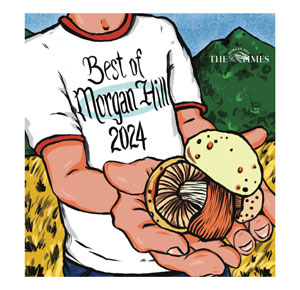Residents on either side of Monterey Road are crying foul about
the city’s latest traffic model, which calls for extensions of
streets both east and west of downtown Morgan Hill.
Residents on either side of Monterey Road are crying foul about the city’s latest traffic model, which calls for extensions of streets both east and west of downtown Morgan Hill.
The city held two informational community meetings earlier this week on a citywide traffic study. A traffic model created by Fehr & Peers, the city’s contractor, found justification for existing roads that are already in the city’s general plan, but cut down many of them from four lanes to two, based on a projected 2030 Morgan Hill population of 55,400.
The traffic model calls for a two-lane extension of Santa Teresa Boulevard, from Hale Avenue to the intersection of Spring and DeWitt avenues. Other recommended roadway improvements include expanding Tennant Avenue from two to four lanes by 2015 and expanding Cochrane Road to six lanes by 2030.
The study also looked at narrowing Monterey Road between Main and Dunne avenues and shifting the future location of the Walnut Grove Drive northern extension. The study explored keeping Depot Street connected at Dunne, rather than cutting it off to allow for grading to bring Dunne under the railroad. The study also found that curving San Pedro Avenue north to meet Monterey Road at Spring Avenue, and creating an intersection there, wasn’t necessary, said Community Development Director Kathy Molloy Previsich.
Frequent city critic Frank Manocchio, who lives on Viewcrest Lane just north of Dunne Avenue, decried the Santa Teresa extension. Manocchio said he was skeptical that the extension would ever be needed – since he was also skeptical that Monterey Road would ever go down to two lanes from four.
“The only reason (the extension) is there is because they want to close downtown,” Manocchio said.
Molloy Previsich said narrowing Monterey was part of the study.
“The idea of possibly narrowing has been talked about for more than 10 years, but it’s never been thoroughly studied,” she said. The city applied for a streetscape planning grant from the Metropolitan Transportation Committee, and part of the grant application was a promise to study new streetscape design for both four- and two-lane approaches. Receiving an MTC streetscape planning grant was the first steps toward making Third Street Promenade a reality, Molloy Previsich said.
Meanwhile, east of Butterfield Boulevard, Michele Buchholtz was disappointed to learn that plans to extend Walnut Grove – possibly through her Diana Avenue home – are still on the books.
“This happened three years ago, this exact same situation. The issues were the same during that time. They didn’t even pass out any fliers anywhere near anybody that were affected by this.”
Buchholtz said she received a notice the day before the first meeting, held Aug. 29.
“They talked about how they advertised in the Morgan Hill Times. Well, I don’t get the Morgan Hill Times,” she said. “The way they’re being so flippant about it, it really made me mad.”
Buchholtz said she’s opposed to the extension because she feels the crime rate would skyrocket in their neighborhood, with offenders at Safeway making a getaway through her neighborhood.
“They’ll go rob people, and scoot on out right to the highway and they’re gone. We’re in a pocket, safe within a pocket, and I don’t think it’s justified. It doesn’t even make sense to have an extension.”
Molloy Previsich said the reason for the Walnut Grove extension would be to improve access for emergency vehicles and to improve connectivity for people who live in Buchholtz’s neighborhood. Fehr & Peers studied four alternatives for the Walnut Grove extension: the existing plan, two alternate routes, and not doing it at all.
Since the traffic study is about Morgan Hill traffic as a whole, the Walnut Grove discussion might be discussed at a separate meeting from the general public hearing the city projects to take place in October, Molloy Previsich said.
Buchholtz said if there were a shopping mall, school, or civic center across the street from her house and people needed to get to it, that would be “worthy of discussion.”
The updated plan isn’t quite as sweeping as the original plan, which was created in 2001. Forty-three road projects have been removed.
The 45-day public review period for the draft environmental impact report ends Sept. 17. Make comments by calling 778-6480, e-mailing Ka*******************@***********ca.gov or sending a letter to Molloy Previsich at 17575 Peak Ave.
The city will then produce a final environmental impact report, which answers comments brought up during the review of its draft version.
Then, the city will schedule public hearings on the updated traffic portion of the general plan. The city hopes to hold these public hearings in October, Molloy Previsich said.








